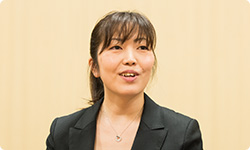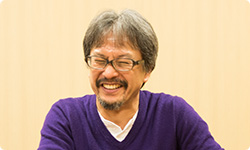Sano-san, as a person that played the Nintendo 64 version of this game… and gave up on it, how did you think about the challenges in the newly created Majora’s Mask 3D?
This time, I did fail at the same scenes that I failed at in the Nintendo 64 version. But now I feel like it’s because I’m not that skilled in playing video games to begin with, so I felt that I was able to accept defeat.
So you’ve accepted your failures because you were convinced that they were your fault. That’s why you were motivated to keep going.
Right. Also, in the Nintendo 64 version, there were scenes where I couldn’t understand why I failed, so I couldn’t get the motivation to keep trying. In the Nintendo 3DS version, however, I felt that I rarely ran into these situations.
You feel that it’s less unreasonable, right?
That’s right. So, even if I never worked on this project and purchased this game as a consumer, I think I would enjoy the game because I can now understand my mistakes better.
So it may sound impossible when the game is described as being as challenging as the Nintendo 64 version, and at the same time it may seem easier to play, but what it really means is that the unreasonableness of the Nintendo 64 version has been taken out, but the challenge is still there.
That’s absolutely right. I repeatedly told the staff to never make this game easier. For example, when you fight the bosses, I believe that you gain true satisfaction after you try many different things, and finally take the right steps to defeat it.
Also, the thrill of not having enough time to get things done in three days is what defines this game, so if that’s taken out it’ll turn into an unmemorable game.
Well, if you clear the game without having the moon fall from the sky at least once, it wouldn’t leave a strong impression either.

I agree! (laughs)
From stuff like that, I think the staff was able to get a consensus of this game in the early stages of development. We spent a lot of time discussing what needs to be fixed, and what shouldn’t.
Based off the “what in the world” list! (laughs)
Yeah. So for the sake of making it easier for the players to solve the riddles, an easy way is to present the obvious answers right in front of them, but we believed that that should never happen.
If that happened, it wouldn’t feel like you’re doing the solving. Without the solving element, it cannot be a Zelda game, right?
(Nods their heads in agreement.)
If the challenges are easy, and the “ se-sa-me-sa~uce♪” 27 sound effect plays in the background, you wouldn’t feel happy at all! (laughs)27. “Se-sa-me-sa~uce♪” (go-ma-da-re~): Popular in Japan, these are the unofficial lyrics for the fanfare sound effect that plays when you find important items from places like treasure chests in-game.
(Laughs)
So, instead of giving out or forcing the answers onto the players, we focused our energy on how well we can communicate the meanings of the missions to the players. By doing this, I think we were able to make the challenges more comprehensible while keeping the same level of challenge as the Nintendo 64 version.
A great example of this would be the boss battles.
That’s right; Aonuma-san said that he wanted to change all of the boss battles.
I’ve been saying that all of the boss battles are weird. All of them. When you first face a boss, it is natural to start looking for its weakness so you can figure out where to attack it. However, in the Nintendo 64 version of this game, you couldn’t see the weaknesses at all.
This is because you created this game as a challenge for the users to figure it out themselves, right?
This would be all right if the users understood this while they were fighting. However, this turned into a game where players won by randomly attacking the boss, without really figuring out what its weakness was.
I personally wanted to fix this too. After I found out we had the same concerns, we reconstructed the battles by focusing on making the objective easier to understand, ensuring that there is the “a-ha” moment for the players, and the strategic elements that are needed to take them down wherever possible.
So, you’ve remade every single boss fight?
Every single one of them. However, their models are virtually the same as the Nintendo 64 version.
However, the bosses’ movements and strategies to take them down have all changed, so it took about the same effort as creating the stages from scratch.
Well you say that quite frankly, even though this is supposed to be a remake.
(Laughs) We put in that much effort in creating this game, so it should be more convenient to play for players who are new to this game. It should also be refreshing to play for those who have played the Nintendo 64 version.
So this time, the GREZZO development team really contributed above and beyond what it takes to make a remake.
In addition to boss battles, we were able to share several ideas this time around, too.
But there were some suggestions that seemed to be over the top! (laughs)
Oh, sorry about that! (laughs) You did keep us on track, though.
The development team had a lot of motivation, so when they showed me some of their ideas, I had to turn down quite a few of them because they was so over the top. On the other hand, they’ve also created things that we’ve never noticed from our end.
This was mentioned earlier, but we thought it would be a waste if the players didn’t discover the fun elements of the game, so we focused on every detail in the game when we were improving and adjusting the contents. For example, we made it so The Bombers28 will give you some hints, and improved The Bombers’ Notebook29.28. The Bombers: The Bombers Secret Society of Justice’s goal is to do good deeds and make people happy. Led by Jim, the society has five young boys as members.29. The Bombers’ Notebook: This is an item that signifies your admission into the Bombers Secret Society of Justice. This notebook automatically fills in the schedules of troubled people.
The Bombers in Clock Town consist of five young boys, and they tell you that they’re collecting information about the town. However, in the Nintendo 64 version, they didn’t give you any useful information. So players might’ve thought, “What’s the point of these kids?” (laughs)

How can you say that when you’re their original creator? (laughs)
(laughs)
So after I felt those regrets, we decided to make these kids more active in the Nintendo 3DS version.
There are many events that occur in the town, but it was easy to miss what was going on in the Nintendo 64 version.
And above that, events happen at a specific time, so if you’re not in the area when the event happens, you will end your experience without ever knowing that such events existed.
So this is why we had the Bombers give out hints.
Also, the Bombers’ Notebook has improved quite a bit. The double screens of Nintendo 3DS systems make it easy to read. You can get much more information out of it, and it now even has an alarm system that would alert you when specific events take place. That’s really convenient, right?
Right. Because they have finally realised their mission as a secret society, they actually started collecting information. (laugh)
So now no one will think “What’s the point of these kids?” when they run into the Bombers in this version of the game.
My perspective about these kids completely changed. This time I think, “Wow, you kids are quite useful!” (laughs)
(laughs)
© 2024 Nintendo.